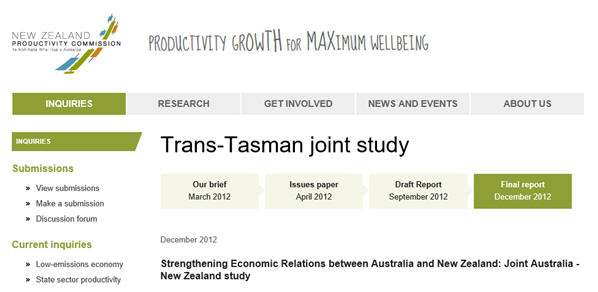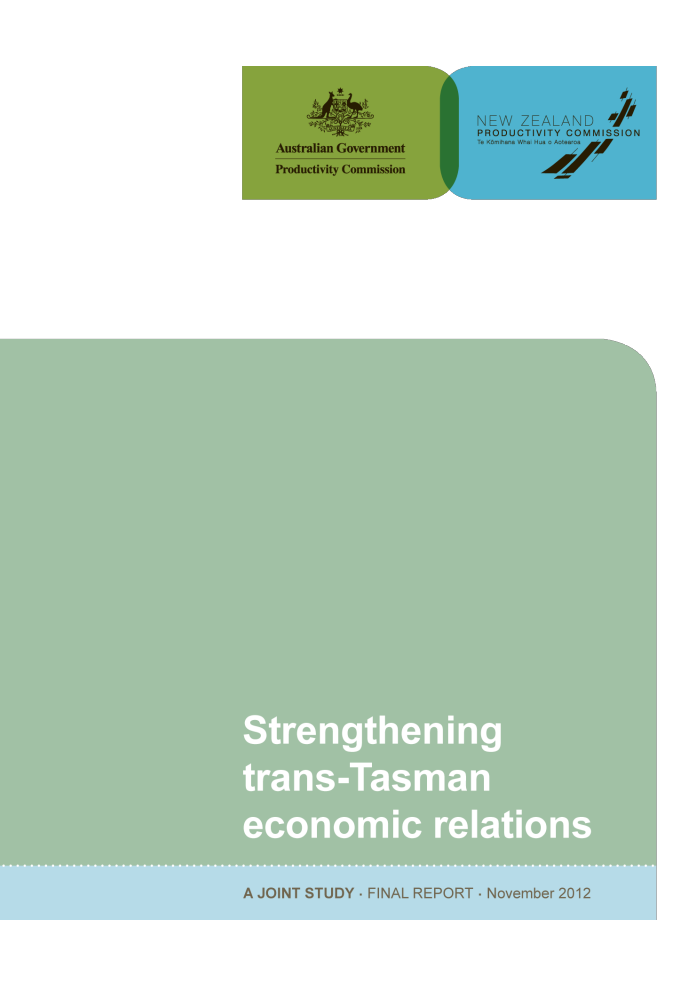Productivity Commissions' - Joint Report (2012)

December 2012
In 2012 the Productivity Commissions of Australia and New Zealand completed a joint report on the trans-Tasman relationship. They found, amongst other things, that Australia's treatment of New Zealand citizens was unreasonable, unjustified, and incompatible with the proper operation of a free movement agreement and a common labour market.
Below are some quotations from Supplementary Paper D of this report, which dealt with migration issues:
Pages 41-42 - “In summary, developing alternative pathways to Australian permanent residency and/or citizenship would provide one approach to remedying the potential for hardship faced by a growing number of non-Protected SCV holders. Moreover, an alternative pathway would provide the right to vote in Australia's electoral system for these 'indefinite temporary' residents.
The Commissions note that detailed work would be required to cost alternative pathways and to consider the wider ramifications for its wider immigration settings and citizenship aims, including the risk of 'back-door' entry from third countries (see below).
The Australian Government should address the issues faced by a small but growing number of non-Protected SCV holders living long term in Australia, including their access to certain welfare supports and voting rights. This requires policy changes by the Australian Government, including the development of a pathway to achieve permanent residency and/or citizenship.”
Page 43 - “Access of New Zealand citizens to Australian tertiary education and vocational education and training should be improved through the provision of student loans. Access should be subject to an appropriate waiting period and debt recovery arrangements.”
Page 44 - “Given the previous Australian and New Zealand Governments agreement to a single trans-Tasman labour market (through the TTTA which subsequently underpinned the CER and the SEM), reviewing the existing principles governing access to social security would seem appropriate along with arrangements governing migration policy.”
Pages 45-46 - “In light of the circumstances and emerging trends in relation to the status of New Zealand people who generally arrived in Australia after 2001 and who have lived and worked in Australia for long periods, consideration could usefully be given to developing similar principles under the CER agreement drawn, for example, from the following:
- policy independence — the country in which the person lives should determine the social security legislation under which he or she is covered (the existing social security agreement between Australia and New Zealand facilitates the transfer of government revenue to fund the social security payments specified in that agreement)
- prevention of government transfer shopping — access to social security should not encourage migration of citizens from one country to another. Waiting periods should apply in most circumstances
- equal treatment — subject to relevant waiting periods or other initial conditions, individuals should have the same rights and obligations as citizens or permanent residents
- portability — each country has its own portability rules for the payments that each country covers. (The existing social security agreement between Australia and New Zealand may affect the rate of some payments for individuals entitled to a payment in one country but living in the other country.)”
Page 49 - “In principle it may be desirable to have fully aligned migration policies for a single trans-Tasman labour market. In practice, given the relatively low levels of 'back door' migration, it would be possible to implement the principle of 'equal treatment'.”
View a PDF of Supplementary Part D of the Productivity Commissions' report.
Read the joint Productivity Commissions' full report from December 2012: Strengthening Trans-Tasman Economic Relations - Final Report
